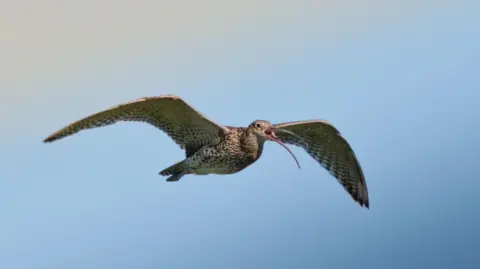The best spring birdwatching spots in Yorkshire
 Getty Images
Getty ImagesBirdwatchers have recommended the best locations in Yorkshire to spot migrating species arriving in the country this spring.
According to the Yorkshire Wildlife Trust, late April is the ideal time to see cuckoos returning from Africa, and turtle doves, reed warblers and terns reappear in wetlands.
The region offers a diverse mix of nature reserves and habitats, including coastal areas, ancient woodland and moors.
Danni Burgess, from Otley, West Yorkshire, said spring was an ideal time to go birding, with longer days providing more opportunities to witness breeding and mating activity.
Ms Burgess, 40, said going birdwatching "allows time to stand still".
"It's such a lovely way to escape where you've just got all the time in the world just to be with nature," she added.
 Danni Burgess
Danni BurgessThe self-employed childminder moved to Otley 13 years ago with her husband because she thought it was the "perfect location" for nature walks, photography and birdwatching.
"We've got some quite unique habitats, such as the moors and Ilkley, where there's lots of heather moors, which attract a lot of the breeding grounds for curlew and lapwings, which is quite unique for the UK.
"Another thing that I really like about Yorkshire is we have little pockets of ancient woodland as well, so that attracts quite a lot of migrant birds."
Ms Burgess has been a birdwatcher for four years.
"It's quite exciting to see that crossover of birds arriving and then saying goodbye to the ones that you've spent the time with over the year."
Where to birdwatch in Yorkshire
 Getty Images
Getty ImagesNorth Yorkshire
North York Moors National Park: The park's moorland makes for great nesting places for curlew, lapwings and black grouse.
Filey Dams Nature Reserve: The last remaining freshwater marsh is a magnet for migratory birds.
South Yorkshire
Sprotbrough Flash Nature Reserve: Near Doncaster on the north bank of the River Don, the area is a good spot for birds that favour wetland.
Graves Park: Sheffield's largest park has a variety of species, including ring-necked parakeets.
West Yorkshire
St Aidan's Nature Reserve: The former open cast mine is Ms Burgess' favourite because its wetland attracts rare birds like the black-necked grebe.
Eccup Reservoir: More than 150 species have been recorded at the site near Alwoodley, on the outskirts of north Leeds.
Rodley Nature Reserve: A great spot for little grebes, tufted ducks and gadwalls.
Zap Coffey-Brittain, 52, who is a carer for his wife, has been birdwatching since his early teens and said he "finds a great sense of wellbeing from being outdoors".
The photographer, based in north Leeds, tries to capture images of species he has never seen before.
"This time of year is probably the more pleasant time of year to be doing things like this, especially as we have this gorgeous weather we've had so far in April 2025, which is really quite unusual," he added.
What is spring migration?
 Danni Burgess
Danni BurgessSpring migration is when birds travel to breed or access seasonal resources like food.
They typically migrate from Africa to the UK in the spring for cooler temperatures and fewer predators.
Some migrations can be short but many birds navigate along flyways - routes birds repeatedly follow - crossing oceans and continents.
They cover thousands of miles and use landmarks like rivers, coastlines or mountains to navigate.
Bad weather, predators or collision obstacles like skyscrapers with reflective glass walls can prove dangerous obstacles to migrating birds.
Nightjars will also be arriving late in the season, as well as swifts and Arctic terns due to their long journeys from Africa and the Arctic.
Source: RSPB
Listen to highlights from West Yorkshire on BBC Sounds, catch up with the latest episode of Look North.
